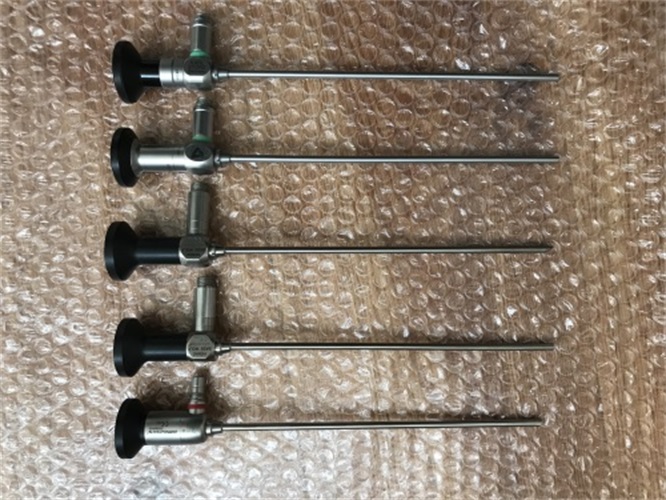欢迎来到匠仁医疗设备有限公司网站!

内窥镜是1853年法国医生德索米奥创制的。内窥镜是一种常用的医疗器械。由头端、弯曲部、插入部、操作部、导光部组成。使用时先将内窥镜导光部接到配套的冷光源上,然后将插入部导入预检查的器官,控制操作部可直接窥视有关部位的病变。
The first endoscope in the world was created by French doctor Desomio in 1853. Endoscope is a commonly used medical device. Composed of head end, bending part, insertion part, operation part, and light guide part. When using, first connect the endoscope's light guide to the matching cold light source, and then guide the insertion part into the pre examination organ to control the operation department to directly observe the lesions in the relevant areas.

最早的内窥镜被应用于直肠检查。医生在病人的肛门内插入一根硬管,借助于蜡烛的光亮,观察直肠的病变。这种方法所能获得的诊断资料有限,病人不但很痛苦,而且由于器械很硬,造成穿孔的危险很大。尽管有这些缺点,内窥镜检查一直在继续应用与发展,并逐渐设计出很多不同用途与不同类型的器械。
The earliest endoscopes were used for rectal examination. The doctor inserted a hard tube into the patient's anus and observed the lesion in the rectum with the light of a candle. The diagnostic data obtained by this method is limited, and patients not only suffer greatly, but also have a high risk of perforation due to the hard instruments. Despite these drawbacks, endoscopic examination has continued to be applied and developed, gradually designing many different types of instruments for different purposes.
1855年,西班牙人卡赫萨发明了喉镜。德国人海曼·冯·海莫兹于1861年发明了眼底镜。
In 1855, the Spaniard Cahesa invented the laryngoscope. German Heiman von Helmholtz invented the ophthalmoscope in 1861.
1878年,爱迪生发明了灯泡,特别是出现微型灯泡后,使内窥镜有了很大发展,临时安排的手术内窥也可达到非常精确的程度。
In 1878, Edison invented the light bulb, especially with the emergence of miniature light bulbs, which greatly developed endoscopes. Temporary surgical endoscopes can also achieve a very precise level.
1878年德国泌尿科专家姆·尼兹创造了膀胱镜,用它可以检查膀胱内的某些病变。
In 1878, German urologist M Niz created cystoscopy, which can examine certain lesions in the bladder.
1897年,德国人哥·基利安设想支气管镜。
In 1897, a German named G ö rgen envisioned bronchoscopy.
1862年,德国人斯莫尔创造了食道镜。
In 1862, German Smoll created the esophagoscope.
1903年,美国人凯利创制了直肠镜,但是到1930年后才开始普遍使用。
In 1903, American Kelly created the concept of colonoscopy, but it was not until 1930 that it became widely used.
1913年,瑞典人雅各布斯改革了胸膜镜检查法。
In 1913, Swedish scholar Jacobs reformed the pleural examination method.
1922年,美国人欣德勒创立了胃镜检查法。
In 1922, American Schindler founded the gastroscopy method.
1928年,德国人卡尔克创立了腹镜检查法。
In 1928, German Carl K established the abdominal endoscopy method.
1936年,美国人斯卡夫进行了脑室镜检试验,直到1962年,才由德国人古奥和弗累斯梯尔创立了脑室镜检法。从此形成一整套镜检法系列。
In 1936, an American named Scarf conducted a ventriculoscopic examination, and it was not until 1962 that the method of ventriculoscopic examination was established by German authors G ü o and F ü rster. From then on, a complete series of mirror inspection methods was formed.
1963年,日本开始生产纤维内窥镜,
In 1963, Japan began producing fiber endoscopes,
1964年研制成功纤维内窥镜的活检装置,这种取活检的特别活检钳能够有合适的病理取材而且危险小。
In 1964, a biopsy device using a fiber endoscope was successfully developed. This special biopsy forceps for biopsy can provide suitable pathological samples with minimal risk.
1965年,纤维结肠镜制成,扩大了对于下消化道疾病的检查范围。
In 1965, fiber colonoscopy was made, expanding the scope of examination for lower gastrointestinal diseases.
1967年开始研究放大纤维内窥镜以观察微细病变。光纤内窥镜还可以用来做体内化验,如测量体内温度、压力、移位、光谱吸收以及其他数据。
In 1967, research began on magnifying fiber endoscopes to observe microscopic lesions. Fiber optic endoscopes can also be used for in vivo laboratory tests, such as measuring internal temperature, pressure, displacement, spectral absorption, and other data.
1973年,激光技术应用于内窥镜的治疗上,并逐渐成为经内窥镜治疗有消化道出血的手段之一。
In 1973, laser technology was applied to the treatment of gastrointestinal bleeding through endoscopy and gradually became one of the methods for treating gastrointestinal bleeding through endoscopy.
1981年,内窥镜超声波技术研制成功,这种把先进的超声波技术与内窥镜结合在一起的新发展,大大增加了对病变诊断的准确性。
In 1981, endoscopic ultrasound technology was successfully developed, which combined advanced ultrasound technology with endoscopy and greatly increased the accuracy of lesion diagnosis.
 公司:匠仁医疗设备有限公司
公司:匠仁医疗设备有限公司 樊经理:13153199508 李经理:13873135765
公司地址:山东省济南市槐荫区美里东路3000号德迈国际信息产业园6号楼101-2室 湖南省长沙市雨花区劳动东路820号恒大绿洲14栋2409室